Lägg upp skrovet

Med pluggen vaxad var jag redo att bygga en båt. Slutresultatet efter målning med högbyggd primer och mycket slipning visas på bilden. Den här är redo för passform.
Klicka på vilken bild som helst för att expandera bilden.
Build the hull on the male mould
What you need
Glass cloth. 2*135gm E cloth and 1x124gm S cloth.
Slow cure epoxy East Coast fibreglass
2 pack high build epoxy primer. SML Paints
Roller
Paint brush
Mixing pots
Safety glasses
The process
Making the hull and components
My first question was what layup to use. Looking at the boat builder sites, I guessed my layup would provide a strong but not too heavy boat however I tried a few layups on a test mould to see what I would get. In the end I used 2*135gm E cloth and 1x124gm S cloth. I am going to build a new boat and use 3 layers of 124gm S cloth which is stronger and will use less epoxy.
At the same time as laying up the hull, I made the hull components using the same layup. I needed a mould for the deck area just aft of the foredeck. The picture shows the mould under construction prior to rubbing smooth.

Components for the bow, stern and bulkhead, simply a glass and epoxy sheet laid on a flat board covered in packaging tape which is a great release agent. For the rudder and servo supports, I laid glass over strip wood wrapped in packaging tape to create a light rigid beam to bond across the boat.

The hull is laid up in the same way as the plug. Pre cut the cloth and mark a centreline on the hull and the cloth. Allow for an overlap of 1 inch on the foredeck.

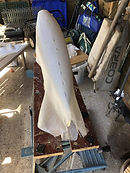
I used West systems slow cure epoxy resin which in the Summer gave me about half an hours work time. Stop work when the epoxy starts to go stringy and clean your tools with Acetone before mixing a fresh pot of epoxy.
I use Nitril gloves which I wash in acetone to remove any sticky epoxy. I also use a full face filter mask although this is not needed. Unlike Polyurethane, epoxy does not smell too bad
To begin the layup, paint the hull with epoxy.
Add the first layer of E cloth and saturate the glass with epoxy using the aluminium roller. Take your time and make sure you get rid of all air bubbles. I worked on the hull first and then turned the mould over to work on the deck. Allow a 1 inch overlap on the deck and cut any excess cloth away with scissors. Keep a jar of acetone handy to keep the scissors clean.
I added more epoxy over the first layer of E cloth prior to adding the second layer. Roll out and finish as per the first layer. Repeat for the final layer of S cloth
Wrap the finished hull tightly in Peel ply.
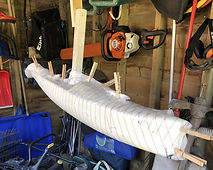
When I built the hull in about 75 degrees, I had to mix a second lot of epoxy for the final layer of S cloth as the first lot started curing.
Once hardened, remove the peel ply, then add 2 coats of high build epoxy primer. Like the plug the hull will look a mess but will look great once sanded.
Sand the hull so you can see through to glass but do not cut any fibres. This will make the hull as light as possible and ready for a top coat of 2 pack polythene which is done after fit out. Fix any faults/holes as necessary.
Once happy with hull finish cut through the centreline of the the foredeck and stern deck. Brad suggested a knife but I used a fine cutter on a Dremel. Prise the hull off the mould. This process was much easier than I thought it would be. The whole structure is flexible so once off the mould so put in a jig to keep the designed shape.
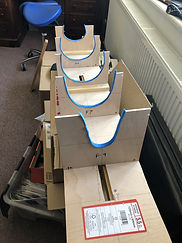
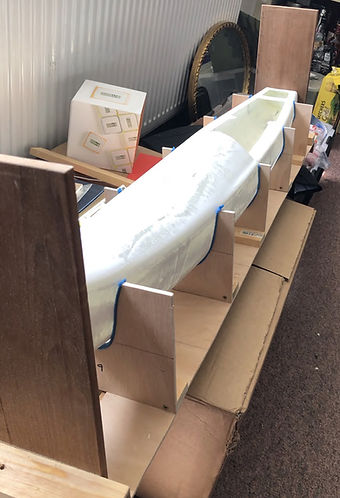


Avsluta huvuddäcket
Så snart skrovet är av formen lägg den direkt i en jigg för att stödja skrovet. Jag klippte ut ramar i plywood med hjälp av planerna och fixade dessa till en stark platt skiva Jiggen kommer att användas för att rikta in fenan och rodret
Klicka på vilken bild som helst för att expandera bilden.
Bond the foredeck and stern deck
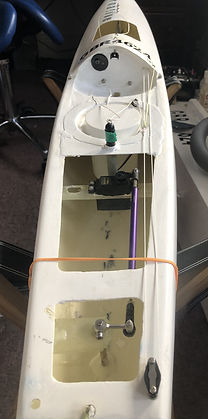
What you need
-
5 minute epoxy
-
Slow cure epoxy
-
Bent piece of wire as long as the foredeck
-
1" glass tape
-
Bow and stern plates
The process
Tape the the top of the previously cut foredeck and stern together with masking tape prior to bonding below.
Sand the underside of the foredeck to provide a key for the 1"tape you are about to apply
Bond the underneath of cut foredeck and stern deck with 1" fibreglass tape.

Allow to cure and remove the masking tape. I put the glass tape underneath the deck and on top but I think you only need to bond underneath and fill the gap on top.
To get the tape all the way up the foredeck, wet the tape with epoxy and roll up. Using the wire with a 1" bend at the end, to support the roll and unroll it right (with the hull upside down) to the end of the foredeck. Once unrolled it should sit flat and use the wire to move the tape if necessary. See image 4.
Remember to put some peel ply over the top of the tape on top of the deck. Image 6. (This was probably an unnecessary step as I think the tape only needs to go on the underside.)
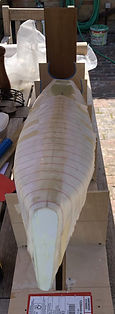
The foredeck will be very strong because you will have 6 layers of glass including the overlay and the 1" tape. Slightly over engineered I think.
Repeat the process on the stern deck. I had to put a plate across the stern and the next bridge as I had not finished the original layup properly. Image 8 and 9.


Having taped on top of the foredeck I had to re apply 2 coats of high build epoxy and sand down. There is no need to do this if you bond underneath the deck only.
I fitted 2 perpendicular end plates onto the jig so I could shape the bow and stern on the hull to be, one, vertical and two, at 90 degrees to the centre line of the boat. Image 10

Trim the bow and stern plate and fit with 5 min epoxy. Spot glue in place initially and then seal and fillet with epoxy and micro balloons.

Bind framdäck och akterdäck
Vad du behöver
5 minuter epoxi
Långsam bota epoxi
Böjd trådbit så lång som fördäcket
1 "glastejp
Bog och akterplattor
Processen
Tejpa upp ovansidan av det tidigare skurna fördäcket och aktern tillsammans med maskeringstejp innan limningen nedan. Se bild 5.
Slipa undersidan av fördäcket för att ge en nyckel till det 1 "band som du ska applicera
Fäst undersidan av det avskurna fördäcket och akterdäcket med 1 "glasfibertejp. Bild 4. Låt härda och ta bort maskeringstejpen. Jag lägger glastejpen under däcket och ovanpå men jag tror att du bara behöver binda under och fylla luckan ovanpå.
För att få tejpen hela vägen upp på fördäcket, blöt tejpen med epoxi och rulla ihop. Med tråden med en 1 "böjning i slutet kan du stödja rullen och rulla ut den rätt (med skrovet upp och ner) till slutet av fördäcket. När den väl är rullad ska den sitta platt och använda tråden för att flytta tejpen om det behövs. Se bild 4.
Kom ihåg att lägga lite skal över toppen av tejpen ovanpå däcket. Bild 6. (Detta var förmodligen ett onödigt steg eftersom jag tror att bandet bara behöver gå på undersidan.)
Fördäcket blir väldigt starkt eftersom du kommer att ha 6 lager glas inklusive överlägget och 1 "-tejpen. Lite överkonstruerad.
Upprepa processen på akterdäcket. Jag var tvungen att lägga en tallrik över akter och nästa bro eftersom jag inte hade avslutat den ursprungliga uppläggningen ordentligt. Bild 8 och 9.
Efter att ha tejpat ovanpå fördäcket fick jag åter applicera 2 skikt av högbyggd epoxi och slipa ner. Du behöver inte göra detta om du bara binder under däcket.
Jag monterade 2 vinkelräta ändplattor på jiggen så att jag kunde fora fören och aktern på skrovet för att vara, en, vertikal och två, 90 grader mot båtens mittlinje. Bild 10
Klipp fören och akterplattan och passa med 5 min epoxi. Plocka lim på plats först och försegla sedan och filéera med epoxi och mikroballonger. Fig 8 visar initial passform.
Ta slutligen bort överflödigt däck så att hålen är synliga enligt planen. Se bild 7 och 8.
På bild 5 är bara akterdäcket på plats. På nästa båt ska jag färdigställa däcket upp till pluggposten.
Nu kommer vad jag tycker är den svåraste delen av byggprocessen. Märkning upp och skär ett hål i skrovet för fenan och limning i ett inriktat fenhölje och binda det till däcket och framåtskottet. När jag bygger min nästa båt lägger jag till bilder på finnens placering.
Klicka på vilken bild som helst för att expandera bilden.
The fin case, bulkhead and forward aft deck
What you need
-
5 minute epoxy
-
Slow cure epoxy
-
Fin
-
Fin case
-
Rudder
-
Rudder stock brass tubes
-
Cross bars for rudder stock and rudder servo mount.
-
Prepared forward part of the aft deck
-
Cut out bulkhead shape to fit under fordeck
-
1"glass tape
-
Various fittings, jib tack bolts, mast ram, mainsheet post, back stay bolt, mainsheet pulley blocks, fairleads to allow the endless mainsheet to go through bulkhead
The Details
Tape the hull into the jig so the shroud points on the deck are parallel to the base of the jig. Everything will be aligned to this.
Measuring from the stern datum, mark the front and back of the fin hole on the outside of the hull. Then mark a centreline which you will have marked on the frames of the jig. This will get the correct alignment for the fin hole. Remove the hull and using the fin, mark the contour of the fin. Cut out the slot for the fin using a Dremel or similar being careful to cut well inside the line. Use sandpaper to open the slot to fit the fin exactly.
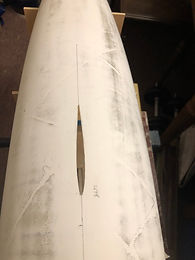
Tape the hull back in the jig. With the fin in the slot, push the fin case over the fin so that the bottom of the case is lying on the hull.
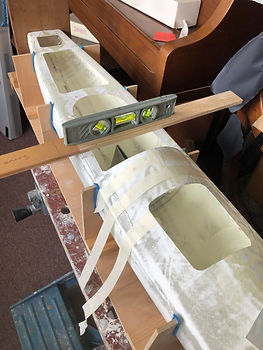
There are two measurements on the plan to align the fin, one shows the tip of the fin where is enters the bulb. This should be 330mm from the bottom of the hull and the other measures from the same fin tip to the bottom of the bow of the boat. If set up correctly the leading edge of the fin should be perpendicular to the waterline. Shape the bottom of the fin box and fin until this is achieved. Ideally the fin should fit all the way into the fin box.
I used some string to determined the position of the tip of the fin.

Reinforce the shroud bolt locations with half an inch of 1" tape and once dry fit the shrouds.
There is a huge amount of strength with this design in this area and no further reinforcement is needed.
Fit the shroud bolt now while you have access to the underside of the deck.
Once the base of the fin box is shaped and the fin aligned, now is the time to dry fit the forward part of the aft deck and trim the top of the fin box until the deck fits snuggly. Spot glue the fin box in place with the fin in the box and support in the right position.


Once fixed seal the fin box to the hull with 5 min epoxy and microballoons with a small fillet. Finally reinforce the fin box to the hull with 1"glass tape and epoxy.

With the fin box in place, dry fit the forward part of the deck with the fin box and forward bulkhead.
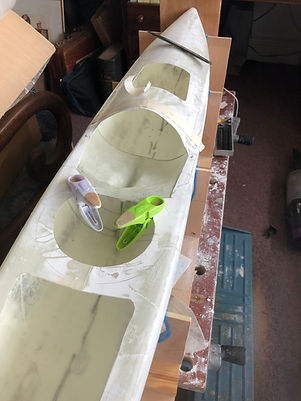
Once happy with fit, do a final check that the forward bulkhead is in the right place from the stern datum. Get this wrong and you will have issues with your mast ram. Spot glue with 5 min epoxy and micro balloon. With 5 min epoxy and micro balloon seal the bulkhead and seal where the fin box connects with the deck. Finally reinforce the top of the fin box with fin one inch tape.
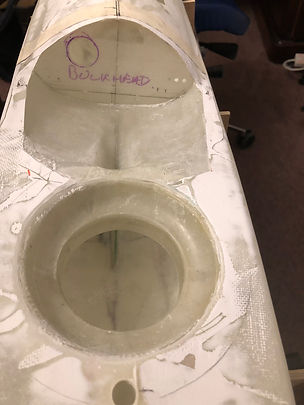

Finally glue the radio pot holder under the deck and seal with epoxy. In my first build I glued the pot on top which looks messy.

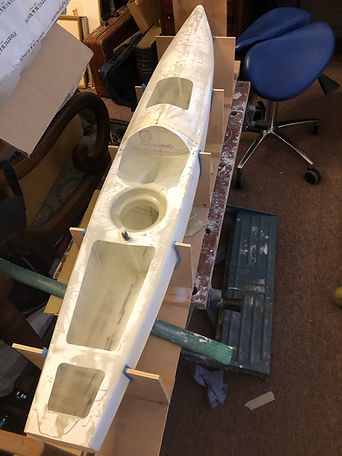
Bond in the cross beams for the servo and rudder stock with one inch tape See image below for positions. Remember to sand the inside of the hull to create a good keyed surface.
Drill the hole in the deck for the fin bolt and mast. Now is the time to check for leaks. Fill the depressed area of the deck forward of the radio pot with water and see if there are any leaks.
Drill a 4mm hole in the hull for the rudder, with the central point located from the jig and distance from the aft datum measured off the plan.
The rudder stock is 2 tubes of brass, one 5mm o/d and one 4mm o/d. The two tubes slot into one another and the rudder post goes inside for a very tight fit.
Mark on the rudder brace bar a line which when a hole is drilled for the stock ensures the trailing edge of the rudder does not extend beyond the stern of the boat. The rudder stock will project a couple of mm above the cross bar. Drill a hole in the centre and ream it wide perpendicular to the hull. Fit the stock in place on the rudder and in the boat. Apply some 5 min epoxy with micro balloon to fix the top of the stock with the rudder exactly aligned with the keel. Leave to set, then seal the stock in the hull and reinforce the top if necessary. The worst is over. My first cross beam was so strong I saved weight by cutting it in half. The next cross beam will be much lighter.
Paint the whole boat in 2 pack polyurethane top coat and lightly rub and t-cut to desired finish


Fit the mainsheet post, backstay bolt, aft pulley for mainsheet, fairleads for sheet control through the bulkhead, setting these as low as possible so they don't interfere with the kicker on a run on port gybe. Fit the 4 jib sheet leads in the foredeck and the 3 tack bolts. Finally, drill a bung hole, push a needle through the centre of the bung, thread a chord and tie to the backstay.

Drill two bolts to hold the winch bracket in the forward bulkhead. Align the winch with the fairleads.
The bracket was just a 90 degree moulding cut to shape around the winch and enough flange to brace it securely to the bulkhead.
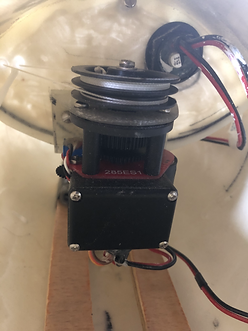

Drill a hole for the mast ram and fit.
Bond a strengthening post in the foredeck around the jib tack area to stop foredeck lifting under load.

Don't fit the radio pot until correctors have been fitted.
Det sista monteringsjobbet på båten
Vad du behöver
Roterarm för roder
Anslutning från rodret till servon
Servo
Mottagare
Batteri LiFeP04 batteri 1600mA (mer än ett helt dygn). Du kan använda så lite som 900mA om du behöver spara vikt.
Vattentät strömbrytare
RG vinsch och stödfäste.
Processen
Borra ett hål i det främre skottet på vänster sida för den elektriska på/av -omkopplaren och passa.
Montera vinschen på stödfästet och lös passform på skottet.
Gör ett hål i tvärfästet för servon och montera och dra kabeln till radiokärlet.
Gör ett hål i ovansidan av radiokärlet strax under dess stödram och för servo- och omkopplingskabeln för batteriet till insidan av grytan genom hålet.
Anslut roderservot till kanal 1 på mottagaren.
Anslut vinschkontakten till kanal 3 och montera den tredje lösa vinschkabeln på en redundant mittstift, säg kanal 5.
Anslut omkopplaren till vinschen. Använd XT30 -kontakter där det är möjligt eller om du vann får du tillräckligt med kraft till vinschen.
Om du slår på strömmen, med någon tur kommer en påslagen sändare att flytta rodret och vinschen.
Det finns ett helt avsnitt om inställningen av radiosändaren HÄR .
Om allt fungerar är du redo att passa den ändlösa arkjusteraren.
Det oändliga arket är ett jobbigt jobb. Jag köpte vinschen med en självspännande returrulle, dvs den är försedd med en fjäder som hindrar plåtlinjen att släppa.
Hitta vinschens slutpunkter genom att flytta kontrollpinnen på sändaren helt upp och ner. Jag använder upp för ark helt ut och ner för helt in.
Lämna kontrollpinnen nedåt (ark in). Ta två rader och trä igenom skottets ledare och spring till vinschen. Den yttre linjen drar in arken och den inre släpper ut arket. På vinschen är den nedre remskivan ark in, den övre fjädrande remskivan är ark ut. Med den yttre linjen, bind av på den nedre remskivan och linda 5 gånger runt remskivan. Knyt den inre linan till den övre remskivan men använd bara en och a halva varv. Håll linorna lätt spända så att du inte tappar omslag på vinschen, du kan nu säkert montera vinschen.
Den yttre linjen löper längs däcket och genom den bakre remskivan nära ryggstödet på styrbordssidan, gängas ut till in och knyts sedan till en 5 mm rostfri ring 2 "från remskivan. Den inre linjen (ark ut) kan spännas, du kommer att känna motståndet hos den självspännande remskivan och bindas till den rostfria ringen så det ändlösa systemet är rimligt tätt. Huvud- och jibbladen knyts till ringen. Det ändlösa huvudarksystemet är komplett.

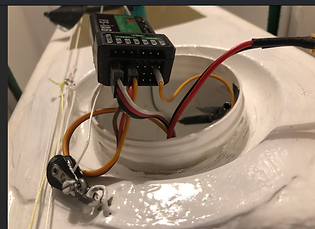

If you turn the power on, with any luck a switched on transmitter will move the rudder and winch.
There is a whole section on the setup of the radio transmitter HERE.
If all works you are ready to fit the endless sheet adjuster.
The endless sheet is a fiddly job. I bought the winch with a self tensioning return pulley, i.e it is fitted with a spring that will stop the sheet line going slack.
Find the end points of the winch by moving the control stick on the transmitter fully up and down. I use up for sheet fully out and down for fully in.
Leave the control stick down (sheet in). Take two lines and thread through the bulkhead fairleads and run to the winch. The outer line will pull the sheets in and the inner will let the sheet out. On the winch the bottom pulley is sheet in, the top sprung pulley is sheet out. With the outer line, tie off on the lower pulley and wrap 5 times round the pulley. Tie the inner line to the upper pulley but only use one and a half turns. Keeping the lines lightly tensioned so you don't lose wraps on the winch, you can now securely mount the winch.
The outer line is run along the deck and through the aft pulley near the backstay on the starboard side, threaded out to in and then tied to a 5mm stainless ring 2" from the pulley block. The inside line (sheet out) can be tensioned, you will feel the resistance of the self tensioning pulley and tie off to the stainless ring so the endless system is reasonable tight. The main and jib sheets will tie off to the ring. The endless mainsheet system is complete.


Slutresultatet
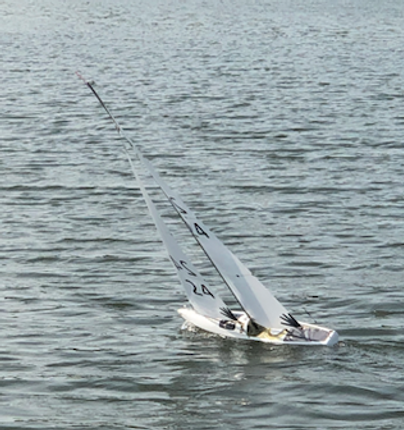
Next Section